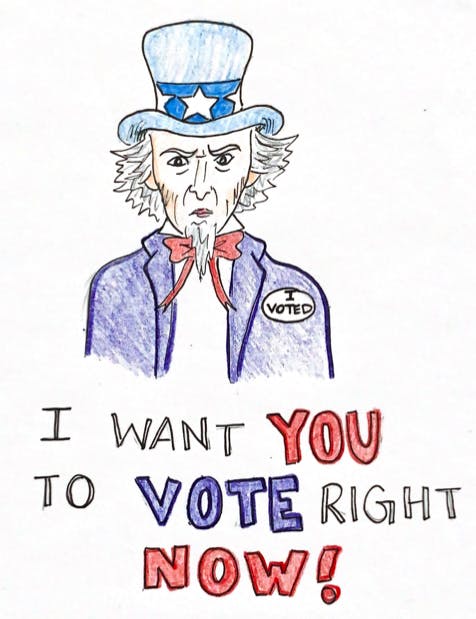This election is the 26th presidential election in which women have been able to vote. As we get closer to Nov. 3, we need to reflect upon the history of voting in the United States. Today’s troubling times far too closely resemble our dark past.
When George Washington was elected, only about 6% of Americans were actually eligible to vote. The privilege was reserved for white, Protestant men over the age of 21 who also owned land. In fact, it wasn’t even until 1856 — five years before the start of the Civil War — that white men were allowed to vote regardless of land ownership status. Fourteen years later, that privilege, though it should have been a right, was constitutionally expanded to all men regardless of race through the 15th Amendment.
At that time, the thought of a Black man taking to the polls and casting a ballot was controversial and horrifying to many Americans. We all know of America’s dark past — of Jim Crow laws and the poll taxes that followed the post-Civil War Reconstruction era. Voter intimidation was practiced without shame.
In 1890, Wyoming became the first state to grant women the right to vote. Eighteen other states, mainly western, followed suit. However, this was not so much because they valued the female opinion as equal but rather because those states saw it as a way of remedying their small populations. 1920 marked the year that women gained the right to vote in all 50 states, though women of color were still excluded. And even in 1924, when Native Americans were given the right to vote, and in 1952, when Asians were given that same right, that didn’t mean that suffrage was truly protected under the law. Voter suppression continued. In 1962, the 24th amendment outlawed the use of poll taxes, but this only applied to federal elections.
On paper, everyone was supposedly given the right to vote, but that right was not formally protected until the Voting Rights Act (VRA) of 1965 removed discriminatory barriers that often kept people of color from voting.

That should have been the end of it. Though long awaited, that should have been the end of voter suppression in America. It wasn’t. Today, marginalized communities face blatant voter discrimination. Limited polling and ballot box locations, voter ID laws and felon voter disenfranchisement all aim to disproportionately affect low income communities, people of color, the elderly and the disabled. I wonder how elected officials in every party can look at themselves in the mirror and think they are part of a democracy.
In 2013, the Supreme Court rolled back the pre-clearance provision of Section 5 of the VRA, a mandate that forced areas with a history of discrimination to obtain clearance from the Department Of Justice when attempting to implement new voting policies.
In 2018, the Florida legislature passed laws that force people with felony convictions to pay off any and all court fines and fees before they are allowed to vote. This often prevents lower income voters from being able to vote in elections that directly affect them. The practice starkly reflects the poll taxes of the Jim Crow era. This requirement disproportionately affects people of color, especially black felons in the state of Florida. It is nothing less than blatant discrimination, against people of color in one of the most important swing states, allowing people in power to stay in power.
This year, in the state of Texas, each county is limited to only a single site where ballots may be dropped off, placing an unfair burden on the disabled and the elderly who often have to be far more careful traveling due to the risk of Covid-19 infection. Absentee voting numbers also reveal entrenched racial discrimination. In the state of Texas, Hispanic Americans make up 12% of voters using absentee ballots and African Americans 10%, but they account for 36% and 18%, respectively, of rejected absentee ballots. One cannot look at these numbers without seeing blatant discrimination.
Voter suppression is a long-standing tradition of the American election process. The vote of a Black man or a Latina woman is not a symbol of democracy — it’s a symbol of perseverance and bravery in the face of great adversity. I realize as I write this that much of the Middlebury community does not truly understand what voter suppression feels like, and most likely never will. Regardless of who you vote for, it is your duty as an American to ensure that the choices you make and people you support today will ensure that the marginalized people of tomorrow get to vote safely. You know, the way you get to.
Max Padilla ‘22 is a photo editor for The Campus.


![Copy of Editorial [Susanna] (3) (1) (2) (1).JPG](https://snworksceo.imgix.net/mbc/11c1e285-1b2c-4ee9-9d20-4a2f24335290.sized-1000x1000.JPG?w=1500&ar=16%3A9&fit=crop&crop=faces&facepad=3&auto=format)

